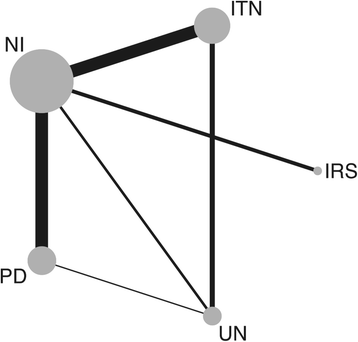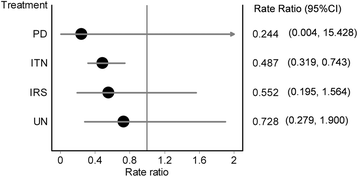Comparative effectiveness of malaria prevention measures: a systematic review and network meta-analysis
- PMID: 29587882
- PMCID: PMC5869791
- DOI: 10.1186/s13071-018-2783-y
Comparative effectiveness of malaria prevention measures: a systematic review and network meta-analysis
Abstract
Background: Malaria causes significant morbidity and mortality worldwide. There are several preventive measures that are currently employed, including insecticide-treated nets (ITNs, including long-lasting insecticidal nets and insecticidal-treated bed nets), indoor residual spraying (IRS), prophylactic drugs (PD), and untreated nets (UN). However, it is unclear which measure is the most effective for malaria prevention. We therefore undertook a network meta-analysis to compare the efficacy of different preventive measures on incidence of malaria infection.
Methods: A systematic literature review was undertaken across four medical and life sciences databases (PubMed, Cochrane Central, Embase, and Web of Science) from their inception to July 2016 to compare the effectiveness of different preventive measures on malaria incidence. Data from the included studies were analysed for the effectiveness of several measures against no intervention (NI). This was carried out using an automated generalized pairwise modeling (GPM) framework for network meta-analysis to generate mixed treatment effects against a common comparator of no intervention (NI).
Results: There were 30 studies that met the inclusion criteria from 1998-2016. The GPM framework led to a final ranking of effectiveness of measures in the following order from best to worst: PD, ITN, IRS and UN, in comparison with NI. However, only ITN (RR: 0.49, 95% CI: 0.32-0.74) showed precision while other methods [PD (RR: 0.24, 95% CI: 0.004-15.43), IRS (RR: 0.55, 95% CI: 0.20-1.56) and UN (RR: 0.73, 95% CI: 0.28-1.90)] demonstrating considerable uncertainty associated with their point estimates.
Conclusion: Current evidence is strong for the protective effect of ITN interventions in malaria prevention. Even though ITNs were found to be the only preventive measure with statistical support for their effectiveness, the role of other malaria control measures may be important adjuncts in the global drive to eliminate malaria.
Keywords: Efficacy; Malaria; Meta-analysis; Preventive measures.
Conflict of interest statement
Ethics approval and consent to participate
Not applicable.
Consent for publication
Not applicable.
Competing interests
Authors declare that they have no competing interests.
Publisher’s Note
Springer Nature remains neutral with regard to jurisdictional claims in published maps and institutional affiliations.
Figures



References
-
- WHO . World Malaria Report. Switzerland: World Health Organization, Geneva; 2017.
-
- WHO . World Malaria Report. Switzerland: World Health Organization, Geneva; 2015.
-
- Murray CJ, Rosenfeld LC, Lim SS, Andrews KG, Foreman KJ, Haring D, et al. Global malaria mortality between 1980 and 2010: a systematic analysis. Lancet. 2012;379(9814):413–431. - PubMed
-
- WHO . Global Technical Strategy for Malaria 2016–2030. World Health Organization, Geneva. Switzerland: WHO Library Cataloguing-in-Publication Data; 2015.
Publication types
MeSH terms
LinkOut - more resources
Full Text Sources
Other Literature Sources
Medical
Molecular Biology Databases
Miscellaneous

